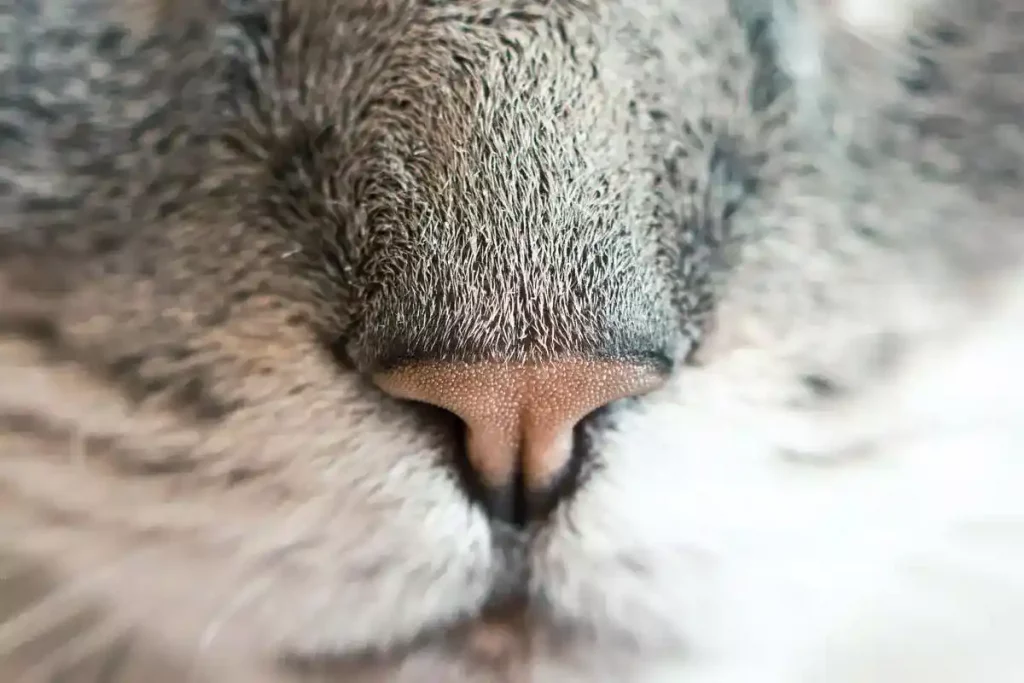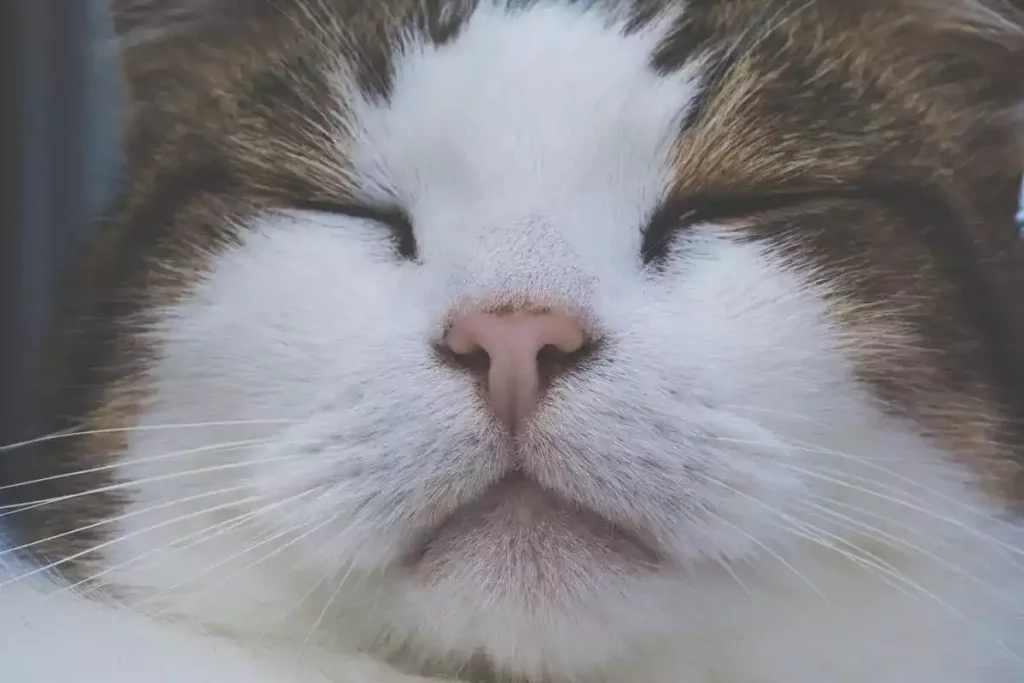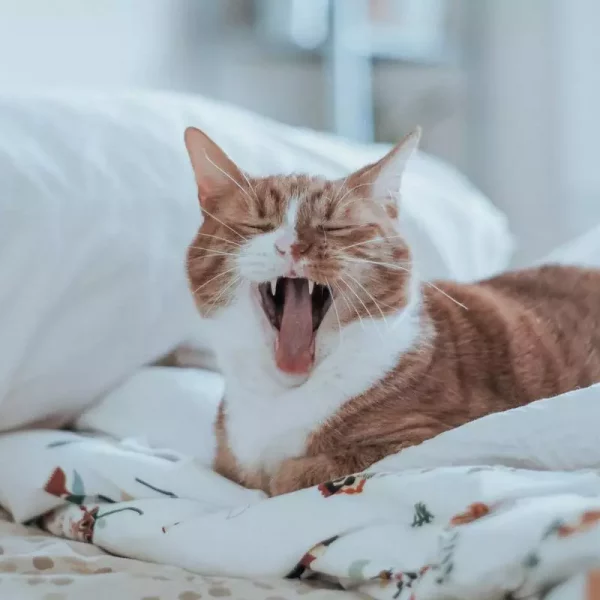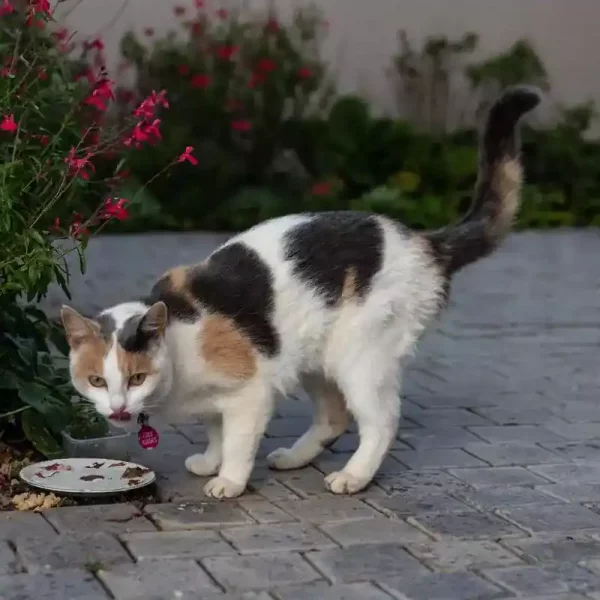A healthy cat’s nose is usually an all-around consistent color. Depending on the breed, it can be black, brown, or even pink.
This is why any discoloration is immediately obvious and sometimes alarming.
What does a white spot on my cat’s nose mean? A white spot on your cat’s nose may indicate something as benign as a pimple, skin discoloration, or a fungal or bacterial infection.
Read on for more information on cat noses and what white spots and bumps that appear on them can mean.
What causes white spots on cat’s noses?
There are many reasons why your cat might get a white spot on their nose. Spots and bumps of different shapes, textures, and colors are actually very common and many of them need minimal intervention.
Please note, I am not a vet and all the information in this guide is through my own online research. If you notice a small white spot on your cat’s nose, particularly if it’s getting bigger, please call your vet.
1. Snow nose
A light white spot on your cat’s nose may mean the beginning of snow nose – a condition where it lightens from black or dark brown to pink. This is a classic case of a white spot on a cat’s black nose.
The name comes from early assumptions that the color change is because of cold weather, but it’s now known that it happens to cats in all climates.

Snow nose is most commonly seen in Persians, Ragdolls, and Abyssinians, but it can affect any breed.
There are no real diagnostic treatments for snow nose because it’s a cosmetic change with no known cause. It may be temporary or permanent.
Overall, there’s no cause for worry.
2. Crate nose
If you crate your cat for extended periods, they may develop a raw spot on their nose that appears as a white bump or mark. This is because they spend a certain amount of their time rubbing their noses in and around their crate.
They may be trying to bury their food or dig their way out. It may also be a sign of anxiety… it’s often found with cats who have been in crates for a week whilst owners are on vacation.
You can gently wash the raw skin on their nose. It may be a good idea to make adjustments to your crate setup to make it a happy and safer space for your cat.
3. Pimples or whiteheads
Just like humans, cats can get pimples, whiteheads and blackheads. Their fur follicles are similar to human hair follicles in that when they get clogged, a pimple may form.
Blocked fur follicles are commonly found on the muzzle, stomach, and genital area of your cat. This will often show as a small or tiny white spot on your cat’s nose.
Dirt and debris can clog your cat’s pores and cause a breakout. When giving them baths, make sure to get into all the nooks and crannies of their nose, chest, and nether regions.
Frequent breakouts in the muzzle and chin area may be because of dirty food and water bowls. Plastic retains oil and dirt, so switch them out for stainless steel or ceramic.
Simple topical treatments are usually enough for acne breakouts on cats. Consult your veterinarian for specific recommendations.
One thing you shouldn’t do is to pop a pimple yourself – it may become inflamed or infected.
4. Nasal hyperkeratosis
Hyperkeratosis is the buildup of keratin on the surface of your cat’s nose. This causes dryness, cracks, and a thick crusty growth on the nose – the most severe cases can protrude as much as an inch – and can look like a white bump on your cat’s nose.
This is a common condition across cat breeds, and usually occurs from middle to old age. It’s generally chronic, meaning you will have to watch out for it and treat it for the rest of your cat’s life.
An effective treatment for the cracked, dry skin is a natural moisturizer. Steroids and antibiotics can be used to treat inflammation due to the keratin buildup. If the excess keratin is significant, it can be carefully cut away.
5. Discoid lupus erythematosus (DLE)
DLE is a common autoimmune disease that targets the skin, usually around the cat’s nose, lips, eyes, and skin. DLE begins with lesions, color changes such as white nose marks, and swelling on the nose.

There is no known cause, though there are environmental and genetic factors involved.
DLE is localized, so topical creams and gels will reduce swelling and discomfort. As sun exposure makes symptoms worse (cats can get sunburn), cats diagnosed with DLE will need to stay indoors.
6. Pemphigus Foliaceus (PF)
PF is another common autoimmune disease that affects middle-aged cats of any breed. Symptoms include scabs and pustules around the face, ears, and head. Possible causes are ultraviolet (UV) light exposure, viral infections, or a genetic predisposition.
PF is diagnosed through a skin biopsy. Mild cases are treated with corticosteroids and topical steroids.
Many cats respond well to this treatment plan and can be weaned off all medication after some time.
7. Vitiligo
Vitiligo is a relatively rare skin condition where the skin loses its natural pigment, resulting in white spots appearing on a cat’s nose, muzzle, lips, and through different parts of their coat.
Vitiligo usually begins in small white spots on the cat’s nose or face, then spreading to the footpads and fur. The full spread occurs within six months of the first appearance of a white spot.
There’s no known cause, but it’s believed to be hereditary. These breeds are at a higher genetic risk of vitiligo:
- Ragdoll
- Maine Coon
- Persian Cat
- Sphynx Cat
- American Shorthair
- British Shorthair
- Abyssinian
- Siamese Cat
- Devon Rex
If there’s no underlying medical cause for the de-pigmentation, there’s no treatment necessary.
Just like snow nose, this condition is purely cosmetic and causes no discomfort for the cat. The white spots on the cat’s nose may wax and wane in appearance over time.
How do I treat a white spot on my cat’s nose?
Most skin problems like white marks and small spots don’t need immediate intervention, but it’s still best to take your cat to the vet once you notice a persistent white marks and discoloration on your cat’s nose.
It may be as simple as a pimple or snow nose, but an accurate diagnosis will lead to proper treatment, or reassurance if treatment isn’t needed. Further testing may include blood work, scraping the affected tissue, allergy testing, or a biopsy.
Common treatments for spots include moisturizing balms for dryness, antibiotics for infections, and anti-inflammatories for allergies.
Your vet may also advise environmental, behavioral, or dietary changes depending on the determined underlying condition.
Can I put Neosporin on my cat’s nose?
Neosporin’s ingredients are generally considered safe for cats. A small amount applied to a minor scrape on your cat’s white nose bumps and marks will not be harmful, but that doesn’t necessarily mean you should use it every time they get wounded.
A cat will likely just lick the Neosporin off as soon as you apply it. Swallowing a small dab won’t cause any harm, but you wouldn’t want them to ingest any more than that.
Simple first aid steps like washing the wound with warm water and brushing away dirt and debris are more than enough for minor scrapes.
If your cat keeps licking their injured nose, it may extend the healing time or cause an infection. If the wound gets worse, it would be best to take them to the veterinarian.
Is the white spot on my cat’s nose cancer?
Nasal cancer in cats is very rare, affecting less than 2% of all cats. A simple raised bump on your cat’s nose most likely isn’t the first sign of cancer.
But if your cat is experiencing nasal discharge (mucus, blood, and/or pus), shortness of breath, eye discharge, and nasal bone erosion, take them to the veterinarian immediately.
Conclusion
To conclude, most white marks on a cat’s nose are nothing to be alarmed about and usually have a very simple explanation.
However, nothing can beat the peace of mind of talking it through with a vet so please do call them the moment you see white bumps and marks on your cat’s nose and face.



Leave a Comment